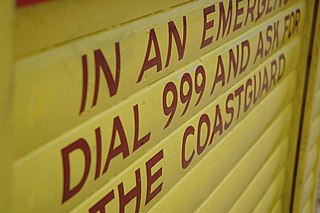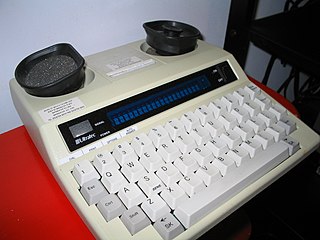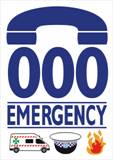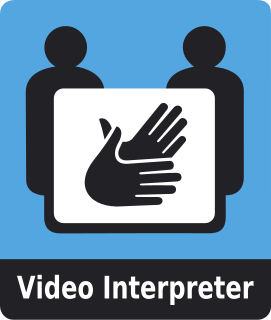Telephony is the field of technology involving the development, application, and deployment of telecommunication services for the purpose of electronic transmission of voice, fax, or data, between distant parties. The history of telephony is intimately linked to the invention and development of the telephone.

9-1-1, also written 911, is an emergency telephone number for the North American Numbering Plan (NANP), one of eight N11 codes. Like other emergency numbers around the world, this number is intended for use in emergency circumstances only, and using it for any other purpose is a crime in certain jurisdictions.
Enhanced 911, E-911 or E911 is a system used in North America to automatically provide the caller's location to 911 dispatchers. 911 is the universal emergency telephone number in the region. In the European Union, a similar system exists known as E112 and known as eCall when called by a vehicle.

In many countries the public switched telephone network has a single emergency telephone number that allows a caller to contact local emergency services for assistance. The emergency number differs from country to country; it is typically a three-digit number so that it can be easily remembered and dialed quickly. Some countries have a different emergency number for each of the different emergency services; these often differ only by the last digit. See List of emergency telephone numbers.
Interactive voice response (IVR) is a technology that allows a computer to interact with humans through the use of voice and DTMF tones input via a keypad. In telecommunications, IVR allows customers to interact with a company’s host system via a telephone keypad or by speech recognition, after which services can be inquired about through the IVR dialogue. IVR systems can respond with pre-recorded or dynamically generated audio to further direct users on how to proceed. IVR systems deployed in the network are sized to handle large call volumes and also used for outbound calling, as IVR systems are more intelligent than many predictive dialer systems.
Caller ID, also called calling line identification (CLID), Calling Line Identification (CLI), calling number delivery (CND), calling number identification (CNID), calling line identification presentation (CLIP), or call display, is a telephone service, available in analog and digital telephone systems, including VoIP, that transmits a caller's telephone number to the called party's telephone equipment when the call is being set up. The caller ID service may include the transmission of a name associated with the calling telephone number, in a service called CNAM.

999 is an official emergency telephone number in a number of countries which allows the caller to contact emergency services for urgent assistance.
Automatic number identification (ANI) is a feature of a telecommunications network for automatically determining the origination telephone number on toll calls for billing purposes. Automatic number identification was originally created by AT&T Corporation for internal long distance charging purposes, eliminating the need for telephone operators to manually request the number of the calling party for a toll call.
Telephone number mapping is a system of unifying the international telephone number system of the public switched telephone network with the Internet addressing and identification name spaces. Internationally, telephone numbers are systematically organized by the E.164 standard, while the Internet uses the Domain Name System (DNS) for linking domain names to IP addresses and other resource information. Telephone number mapping systems provide facilities to determine applicable Internet communications servers responsible for servicing a given telephone number using DNS queries.

A telecommunications device for the deaf (TDD) is a teleprinter, an electronic device for text communication over a telephone line, that is designed for use by persons with hearing or speech difficulties. Other names for the device include teletypewriter (TTY), textphone, and minicom.

A telecommunications relay service, also known as TRS, relay service, or IP-relay, or Web-based relay service, is an operator service that allows people who are deaf, hard of hearing, deafblind, or have a speech disorder to place calls to standard telephone users via a keyboard or assistive device. Originally, relay services were designed to be connected through a TDD, teletypewriter (TTY) or other assistive telephone device. Services gradually have expanded to include almost any real-time text capable technology such as a personal computer, laptop, mobile phone, PDA, and many other devices. The first TTY was invented by deaf scientist Robert Weitbrecht in 1964. The first relay service was established in 1974 by Converse Communications of Connecticut.
VoIP spam or SPIT is unsolicited, automatically dialed telephone calls, typically using voice over Internet Protocol (VoIP) technology.
In telecommunications, a long-distance call (U.S.) or trunk call (U.K.) is a telephone call made to a location outside a defined local calling area. Long-distance calls are typically charged a higher billing rate than local calls. The term is not necessarily synonymous with placing calls to another telephone area code.

000 is the primary national emergency number in Australia. The Emergency Call Service is operated by Telstra and overseen by the Australian Communications and Media Authority, and is intended only for use in life-threatening or time-critical emergencies. Other emergency numbers in Australia are 112 for GSM mobile and satellite phones, which is answered by a 000 operator and 106 for TDD textphones. 000 was also the emergency number in Denmark and Finland until the introduction of the 112 number in 1993 and in Norway until 1986, when the emergency numbers diverted to 001 for fire brigade, 002 for police and 003 for ambulance. Those numbers changed in 1994 to 110, 112 and 113 respectively.

A video relay service (VRS), also sometimes known as a video interpreting service (VIS), is a video telecommunication service that allows deaf, hard-of-hearing, and speech-impaired (D-HOH-SI) individuals to communicate over video telephones and similar technologies with hearing people in real-time, via a sign language interpreter.
Telerehabilitation is the delivery of rehabilitation services over telecommunication networks and the internet. Most types of services fall into two categories: clinical assessment, and clinical therapy. Some fields of rehabilitation practice that have explored telerehabilitation are: neuropsychology, speech-language pathology, audiology, occupational therapy, and physical therapy. Telerehabilitation can deliver therapy to people who cannot travel to a clinic because the patient has a disability or because of travel time. Telerehabilitation also allows experts in rehabilitation to engage in a clinical consultation at a distance.
Telephone interpreting is a service that connects human interpreters via telephone to individuals who wish to speak to each other but do not share a common language. The telephone interpreter converts the spoken language from one language to another, enabling listeners and speakers to understand each other. Interpretation over the telephone most often takes place in consecutive mode, which means that the interpreter waits until the speaker finishes an utterance before rendering the interpretation into the other language.
A revoicer provides communication assistance by carefully listening to the speech patterns uttered by an individual with a speech disability, using lipreading (speechreading) and attention to other cues if necessary for full understanding of the utterances, and then repeats the same words in a manner that is more clear and understandable to the listener. Revoicers generally have excellent skills in auditory phonetic/phonemic pattern recognition, similar to those utilized by a court reporter or stenographer, to identify the sounds of speech of the speaker.
An organic minute is defined as the natural state of which telecommunications relay calls are processed between caller and called parties through Communications Assistant that are in conversation mode; that is, no incentives to encourage unnecessary relay minutes.
Assistive Technology for the Deaf and Hard of Hearing is special technology made to assist them including Hearing aids, Video relay services, tactile devices, alerting devices and technology for supporting communication.







